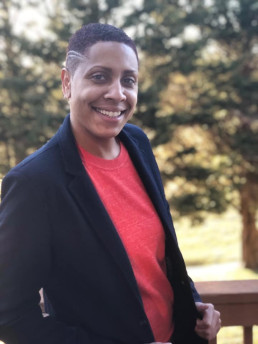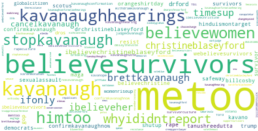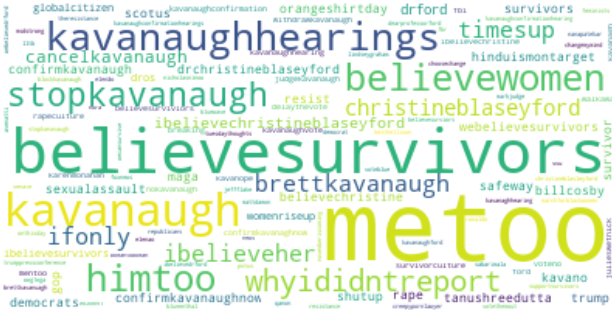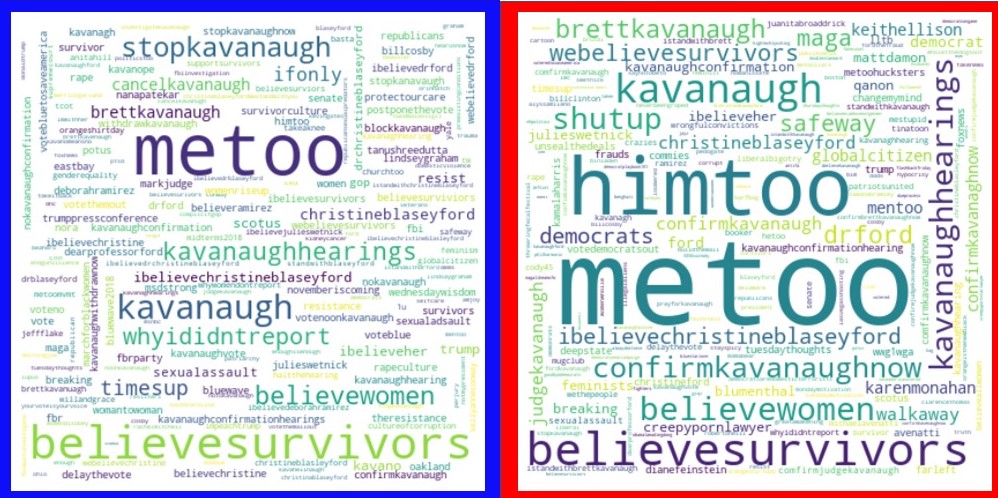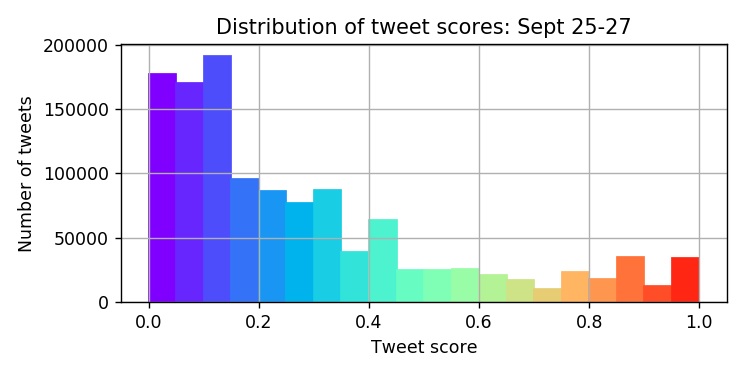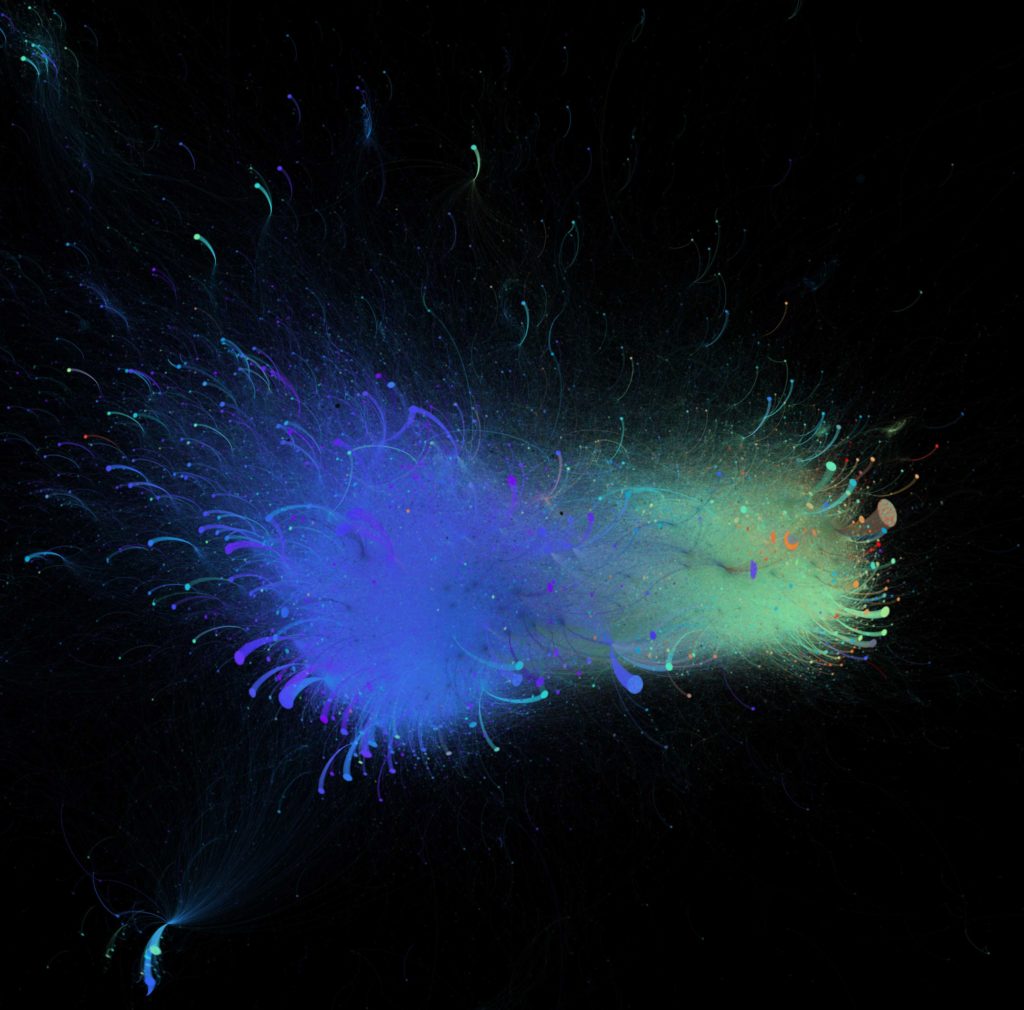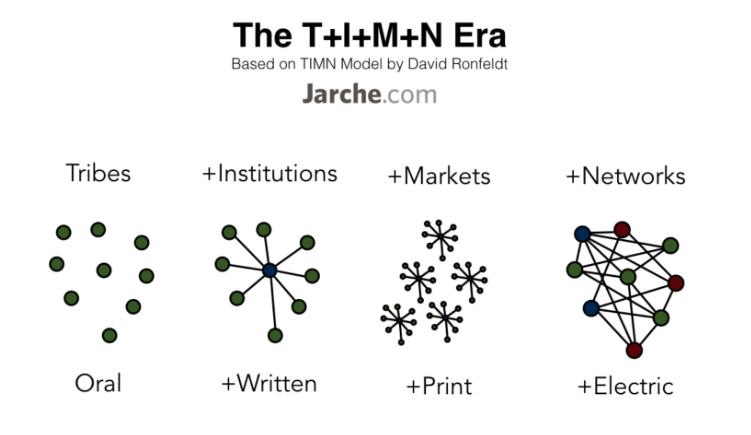Denisha Craig
Denisha Craig is a child sex abuse prevention advocate and an Independent Consultant for Resonance Network and Leadership Learning Community (LLC’s) WEB network. Based in Maryland, Denisha supports networks organizing around similar causes move through key processes to achieve their goals. Her work includes weaving together individuals, strategic planning, facilitation design, with high levels of interaction and participation, network thinking, and leadership skills.
Denisha has a healthy goal to use hashtag activism (ex. #metoo #blacklivesmatter) to normalize the discussion around preventing child sex abuse in every home. As founder of Paranoia to Prevention (#paranoiatoprevention) Denisha raises awareness on adverse childhood experiences (ACE’s).
Conversations in Networks
In early September I started collecting #MeToo tweets and stumbled into a big-data look at #MeToo and the Kavanaugh confirmation. As I posted previously, the Twitter network is radically split into red and blue factions. (FiveThirtyEight subsequently wrote about this divide, based not on Twitter but on polls, and arrived at the same conclusion.) Now I want to post an update on this project, which is more than ever a work in progress. I’m especially wanting input from #MeToo movement organizers, who hopefully have real questions that can guide where this research goes next.
I am still collecting tweets. Here is an updated map, showing the same left-right split. The network appears to have a couple significant bridges and a “super-left” tail:

We know it’s been a momentous few weeks for #MeToo. Let’s look at the data. See how #MeToo tweeting spiked over 100,000 per hour on Sept 27, the day of Ford’s testimony.
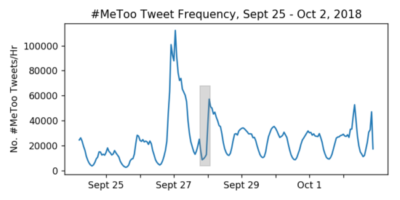
There was a huge spike of #MeToo tweets Sept 27.
The grey bar indicates missing data from Sept 28.
What tweets exactly are being counted? Over Sept 15-27 I curated a list of hashtags to track, aiming to capture #MeToo spirit without taking unnecessary Kavanaugh crossfire. During that time, #BelieveSurvivors grew from zero to the number one trending hashtag on Twitter of Sept 24. My final list of 20 “#MeToo hashtags” also includes #WhyIDidntReport, #BelieveWomen, #MenToo, #MeTooMvmt, #SurvivorCulture, and #HimToo. Below is a word cloud showing all the top hashtags from the 5 million tweets charted above.
All these maps and charts are a nice start, but how can we better understand what’s happening on the two sides of this “conversation”? One way is to make separate word clouds, one for each side:
We can see some important differences based on these word clouds, like #HimToo on the right and #WhyIDidntReport on the left. But the differences are obscured by the overwhelming similarities. For example, barely a day after #BelieveSurvivors exploded on the left, it became just as huge on the right, and so both word clouds feature this hashtag prominently, which does not help us understand the differences between left and right.
Let’s look at this problem another way. We’ve got 5 million Tweets from 1.5 million users. Based on network clusters, we can categorize many (maybe most) of those users as “left” or “right.” What happens if we make one bucket of tweets from known “left” users, another bucket of tweets from known “right” users, and then teach a computer program to recognize the difference between a “left” tweet and a “right” tweet? If we succeed, then we can use that computer program to score any #MeToo tweet on left-vs-right partisanship, including tweets from unknown users and without even drawing a network map.
We have formulated a classic problem of machine learning. Skipping some technical detail, we train a classifier to recognize our two categories of #MeToo tweets with roughly 87% accuracy. Not bad. If we crack open the resulting classifier, we find model coefficients that tell us exactly which words are most strongly associated with each side of the #MeToo divide. The bigger the bar, the more influence it has on our “prediction”:

The words listed above do not have any extraneous hashtags that are popular on both sides. We are looking at the most significant single-word indicators that a tweet is either “left” or “right.” The top two and bottom two make perfect sense. The left champions #SurvivorCulture and #StopKavanaugh. The right champions #HimToo (a cry to protect men from false accusations) and #ConfirmKavanaughNow. Some words included in the list are not obviously partisan (#world) and we’d want to do more model-training if we were really serious about classifying lots of future tweets very accurately.
Let’s run with our first-draft model for now. With it, we can actually compute, for any #MeToo tweet, the probability that it’s left or right. If a tweet scores 0.0001, then it’s almost certainly left, and it it scores 0.9999 then it’s almost certainly right. If we can score tweets this way, then we can aggregate tweet scores user by user and estimate how far each individual leans left or right (on a zero-to-one scale), based on what they’re literally saying and without having to bother with a map. Below we see a curve of tweet scores based on Sept 25-27.
The rainbow in the chart above shows how we assign a color to each score value from zero to one. This will be handy when we start assigning scores to nodes and edges in network maps.
Based on the distribution above, let’s consider a more nuanced classification than the binary “left” vs “right.” I’ve proposed four categories, and selected 2-3 of the most-retweeted examples within each category. It looks good at the far ends, with a miss or two in the mid-left and mid-right.
[ap_spacing spacing_height="15px"]
Far Left: ~500K tweets scoring 0.0-0.15:
"i was raped at Yale. i was groped at parties in dke’s house—#kavanaugh’s fraternity at yale—and was told as a freshman to avoid their “rape basement.” multiple dear friends were raped by yale dke brothers & by boys from elite prep schools. i believe ramirez. #believesurvivors"
"by scheduling a vote on judge kavanaugh before dr. ford has even testified, senate republican leaders are saying loud and clear: they don’t care what she says. #believesurvivors"
"mr. president, enough. a supreme court nomination is not worth more than the lives of survivors. there must be a full investigation of these allegations of criminal behavior, and judge kavanaugh’s nomination must be withdrawn."
[ap_spacing spacing_height="15px"]
Mid Left: ~300K tweets scoring 0.15-0.35
"ladies, a question for you: “what would you do if all men had a 9pm curfew?” dudes: read the replies and pay attention. #metoo #kavanaugh #cosby #feminism #maleprivilege #privilege"
"tune in as democrats show our support for dr. christine blasey ford. #believesurvivors"
"so, the same party that wants to force teenage boys and girls to shower together in the name of transgender rights is also leading #metoo against sexual predators?"
[ap_spacing spacing_height="15px"]
Mid-Right: ~200K tweets scoring 0.35-0.75
"modern feminism has never been about equality with men.
it has always been about special treatment and exemption from all responsibility. many condemned me for being one of the first to speaking out against #metoo. now it’s toxicity is on full display. #defendourboys"
"you can like or not like @michaelavenatti but what he just put out is a sworn affidavit alleging that kavanaugh and mark judge regularly gang raped women including once his client julie swetnick. i believe survivors."
"it’s all about #metoo & #webelievesurvivors unless the survivors support @realdonaldtrump or the sexual predator is a democrat. ain’t that right @keithellison @maziehirono @senfeinstein & @billclinton @dnc the party of hypocrisy
[ap_spacing spacing_height="15px"]
Far Right: 100K tweets scoring 0.75-1.0
"i’m loving the hashtag #himtoo. it appears to be a movement built of men who have had their lives and families destroyed by false allegations and a lack of due process. radical feminism has become problematic and needs to be addressed. dr. luke, brett kavanaugh… #himtoo"
"serious question. are keith ellison, sen. sherrod brown, sen. booker and sen. tom carper signing on? i know they’re democrats but thought it’s only fair to ask given their history’s on this subject."
[ap_spacing spacing_height="25px"]
COMING SOON…
With a good scoring and coloring system, along the lines described above, we can apply those colors to every node and edge of a twitter map, and see “exactly” where left- and right-leaning discussions are happening, along with some shades in between the extremes. Something like this:
Prototype #MeToo Twitter network map,
With color spectrum to indicate extent of left vs right expression.
Let me know what you think. I am especially interested in movement organizer folks who have suggestions for improving the relevance and usefulness of this method to provide them with actionable information.
Originally published 10/9/18 at Connective Associates.
Moving (rapidly) to a Network World
[ap_spacing spacing_height="10px"]I’m a network hunter. My idea of fun is to spend hours traveling through the web world, spying new networks and learning all I can about network development.
From my vantage point, the number of networks formed during the last decades has been extraordinary (though sadly no one is tracking this growth so we have no real research verifying the number of existing networks).
Virtually all of us are part of social networking sites, such as Facebook, Twitter and Instagram, and have access to virtual communication channels that open up huge opportunities for people to connect in novel ways.
[ap_spacing spacing_height="20px"]Networks are appearing in every aspect of life:
- Virtually all research is now done through networks of researchers and institutions
- Businesses are forming networks with customers and other businesses, and even organizing internally more as a network (zappos, etc).
- Service organizations are forming networks to streamline referral systems [ap_spacing spacing_height="15px"]
- 20% of married couples now meet on online dating networks
Then there is the particular set of networks that fascinate me (and hopefully you dear reader!). They are all about change. These networks range from those working on some sort of incremental change to those who see their network efforts as transformational, helping us co-create a world that is good for all of us.
[ap_spacing spacing_height="30px"]Types of Transformational Networks
There are many, many different change or transformational networks currently operating. Here are just a few examples:
[ap_spacing spacing_height="15px"]
Sector or Issue Networks
- Environment and sustainability: climate change networks, large landscape conservation networks, transition networks, electric car networks, reuse and upcycling networks, children and nature networks, community solar networks, Fire Learning Network, REAMP [ap_spacing spacing_height="20px"]
- Food: food access networks, local food networks, food policy networks, food hub networks, food business networks, organic food networks, healthy school lunch networks, school garden networks [ap_spacing spacing_height="20px"]
- New Economy: regional economy networks, makerspace networks, sustainable business networks, social capital networks, cooperative networks, networks to support local business, time banks and alternative currency networks,seed exchange networks, FabLabs Network, European Network of Living Labs (ENoLL), Sunday Soup networks[ap_spacing spacing_height="20px"]
- Housing networks: co-housing networks, end homelessness networks, intentional communities networks[ap_spacing spacing_height="20px"]
- Education: early childhood networks, childcare networks, education innovation networks, Flipped Learn Network[ap_spacing spacing_height="20px"]
- Health: health access networks, obesity prevention networks, Self-help networks, self-care networks, cancer-free economy network[ap_spacing spacing_height="20px"]
- Arts Networks[ap_spacing spacing_height="20px"]
- Criminal Justice Networks[ap_spacing spacing_height="20px"]
- Immigrant rights networks[ap_spacing spacing_height="20px"]
[ap_spacing spacing_height="15px"]Cross sector
- Women and Girls: ending violence against women networks, domestic violence networks, girls code networks, end trafficking networks, mom’s rising network[ap_spacing spacing_height="20px"]
- Leadership networks, network leadership networks, network consultants network, Movement NetLab[ap_spacing spacing_height="20px"]
- Gender Networks: LGBT Network,[ap_spacing spacing_height="20px"]
- Communications: open source networks, platform networks, peer to peer networks, community broadband networks, digital for good networks[ap_spacing spacing_height="20px"]
- New politics: new democracy networks, study group networks, community organizing networks,[ap_spacing spacing_height="20px"]
- Movement networks: Occupy Wall Street, Occupy Sandy, #MeToo, Immigrants Rights Movement[ap_spacing spacing_height="20px"]
- Geographic: neighborhood networks, regional environmental networks[ap_spacing spacing_height="20px"]
- Undoing racism and privilege: Racial justice networks, truth-telling networks, sustainable communities networks, ending white privilege networks [ap_spacing spacing_height="20px"]
- Specific cross sector networks: cross sector networks bringing together energy efficient housing groups with low-income housing groups[ap_spacing spacing_height="20px"]
- Advocacy networks: The Advocacy Network on Disabilities, Autistic Self-advocacy Network, Rocky Mountain Immigrant Advocacy Network (RMIAN), Prisoner Advocacy Network Domestic Employers Network[ap_spacing spacing_height="20px"]
- Governance & policy networks[ap_spacing spacing_height="20px"]
- Learning Networks/Communities of Practice: Healthcare breakthrough learning network,[ap_spacing spacing_height="20px"]
- Technology Networks[ap_spacing spacing_height="20px"]
- Philanthropy networks
Pretty amazing! I was surprised myself at the breadth of the networks out there.
I know I am missing a lot of other networks, especially non-U.S. and international ones. Please add others in the comments section below and I’ll add them to the list above.
[ap_spacing spacing_height="30px"]Networks are the way we act
But few of us (even me until recently) realized that we are rapidly moving to a place where networks are the primary way we see and act in the world. This wonderful video by RSA and Manuel explains this shift.
[ap_spacing spacing_height="30px"]Harold Jarche shows this shift in the diagram below:
In the next decade organizations will increasingly be part of external networks and, at the same time, will start to become more networked internally. I believe many nonprofits (and foundations!) will decrease their staff numbers because they are shifting their role to catalyzing and coordinating collaborative projects emerging from diverse networks. Foundations will have less staff because they are putting their dollars into pools of funds with decisions made for their distribution done through participative processes involving networks (more on that in a later post!) Former staff will become free agents and consultants, working as peers in the relevant networks, joining in many collaborative projects with many different partners.
[ap_spacing spacing_height="20px"]
Over half of the workforce will be free agents
By 2040, over half of the workforce will be free agents, and increasing numbers will be working in collaboratives rather than for employers. As a consultant, each year I am part of 6-12 collaborative projects, each with a different network, some short term and others multi-year commitments. I’m also part of around 3-6 unpaid collaborations: helping to develop an upcycling clothing production network in our community, working with others to develop modules for the network field, and helping to organize learning popups to deepen our understanding of topics such as self-organizing or network governance. I love my work and am never bored! (And I am almost never “too busy” or stressed out!)
However, the biggest shift is likely to be our increasing involvement in policy and governance networks. In the next decade, using participative co-design and decision-making platforms, more people will be participating in policy making and in co-creating new community institutions. Already some cities engage hundreds of people in designing public spaces, or conduct participative budget processes. Innovative political candidates are using videoconferencing and breakout rooms so that their constituents can co-design their platform.
We are just beginning to understand all the ramifications of these shifts, but it’s clear that we need to spend much more time learning about the possibilities that this shift will open for us.
I hope you will share your thoughts and networks in the comments section below.
